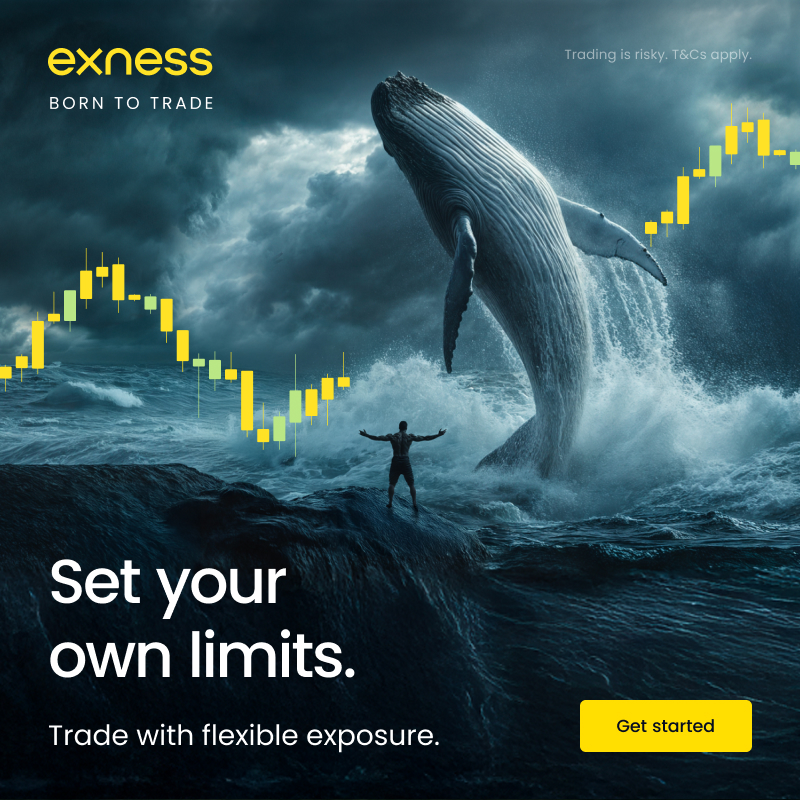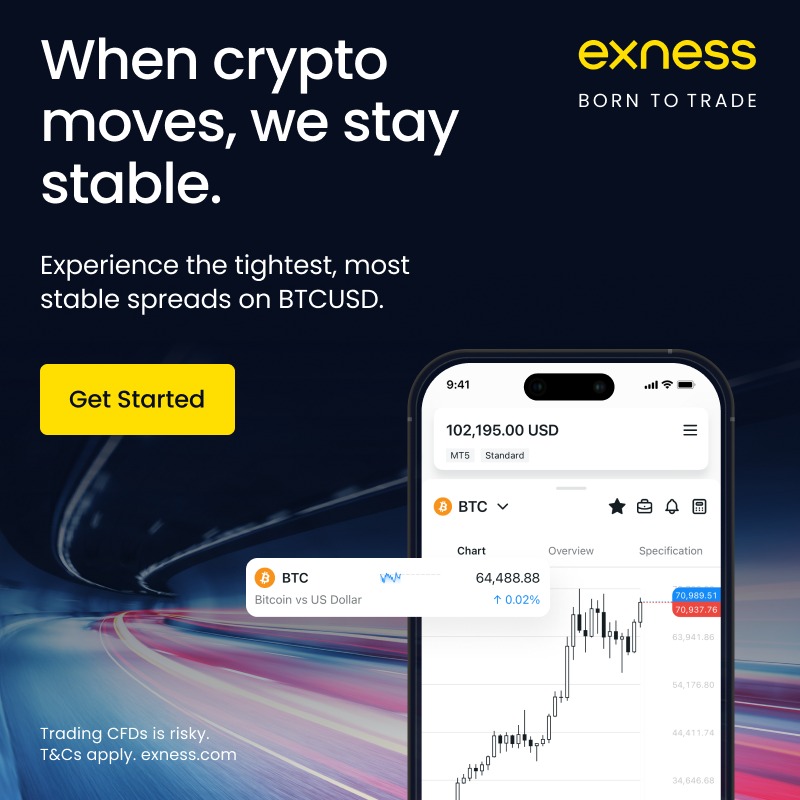
9 minute read
Exness Zero vs. Pro Account: Choosing the Best for Your Trading Needs
from Exness Blog
When choosing a trading account with Exness, a globally recognized forex and CFD broker, traders often face the decision between the Zero vs Pro Account. Both accounts are part of Exness’ professional offerings, tailored for experienced traders seeking advanced trading conditions. However, they cater to different strategies, priorities, and cost structures, making it crucial to understand their differences to select the best fit for your trading goals. In this comprehensive guide, we’ll compare the Exness Zero Account vs. Pro Account, diving deep into their features, costs, benefits, and ideal use cases to help you make an informed decision.

Introduction to Exness: A Trusted Broker
Founded in 2008, Exness has established itself as a leading broker, serving millions of traders worldwide across forex, cryptocurrencies, commodities, indices, and stocks. Regulated by top-tier authorities like the Financial Conduct Authority (FCA), Cyprus Securities and Exchange Commission (CySEC), and Financial Sector Conduct Authority (FSCA), Exness is known for its transparency, competitive spreads, and robust trading platforms, including MetaTrader 4 (MT4), MetaTrader 5 (MT5), and its proprietary Exness Terminal.
Exness offers a variety of account types, categorized into Standard (for beginners) and Professional (for experienced traders). The Zero Account and Pro Account fall under the Professional category, designed for traders who demand low spreads, fast execution, and advanced tools. But which account is right for you? Let’s break it down.
Overview of Exness Zero Account
The Exness Zero Account is designed for traders who prioritize tight spreads and are comfortable with a commission-based fee structure. It’s particularly popular among scalpers, high-frequency traders, and those trading during volatile market conditions. Here are the key features of the Zero Account:
Spreads: Offers zero spreads on the top 30 instruments for 95% of the trading day and on other instruments for 50% of the time, depending on market volatility. Floating spreads may apply during high-impact events like economic news or rollovers.
Commission: Starts at $0.05 per lot per side, varying by instrument. For example, a 1-lot trade on EUR/USD might incur a $5 round-trip commission but no spread cost during zero-spread periods.
Execution: Uses market execution, ensuring no requotes but filling orders at the best available price, ideal for fast-paced strategies like scalping.
Minimum Deposit: Typically $200, though this may vary by region.
Leverage: Up to 1:Unlimited (subject to conditions), allowing traders to maximize exposure but requiring careful risk management.
Trading Platforms: Supports MT4, MT5, and Exness Terminal.
Instruments: Access to forex, metals, cryptocurrencies, indices, and energies.
Swap-Free Option: Available for Islamic accounts, eliminating overnight swap fees.
The Zero Account is ideal for traders who execute multiple trades per session, particularly those using Expert Advisors (EAs) or automated trading systems, as the low spreads and precise execution minimize costs for high-volume strategies.
Overview of Exness Pro Account
The Exness Pro Account is tailored for traders who prefer a commission-free structure with slightly wider spreads. It’s suitable for day traders, swing traders, and those who trade moderate volumes. Here’s a breakdown of its key features:
Spreads: Starts from 0.1 pips, which is low but not as tight as the Zero Account. For example, a 1-lot EUR/USD trade might cost $1–$2 in spread, depending on market conditions.
Commission: No commissions, making it cost-effective for traders with lower trade frequencies.
Execution: Offers both instant execution (for most instruments, with potential requotes) and market execution, providing flexibility based on trading strategy.
Minimum Deposit: Typically $200, similar to the Zero Account, though regional variations apply.
Leverage: Up to 1:Unlimited, subject to conditions, offering high flexibility.
Trading Platforms: Supports MT4, MT5, and Exness Terminal.
Instruments: Full access to forex, metals, cryptocurrencies, indices, and energies.
Swap-Free Option: Available for Islamic accounts.
The Pro Account appeals to traders who value simplicity and cost transparency, particularly those who trade less frequently or focus on longer-term strategies like swing or trend-following trading.
Key Differences Between Zero Account and Pro Account
To choose between the Exness Zero Account and Pro Account, let’s compare them across critical dimensions:
1. Spreads and Costs
Zero Account: Offers zero spreads on major instruments for most of the trading day, but charges a commission starting at $0.05 per lot per side. This structure benefits high-volume traders, as the absence of spreads can significantly reduce costs for frequent trades. For example, a scalper executing 10 trades of 1 lot on EUR/USD might pay $50 in commissions but save on spread costs.
Pro Account: Features low spreads starting from 0.1 pips with no commissions. This is advantageous for traders with fewer trades, as the spread cost (e.g., $1–$2 per lot on EUR/USD) is often lower than the Zero Account’s commission for low-to-moderate trade volumes.
Winner: Depends on trading style. Scalpers and high-volume traders benefit from the Zero Account’s tight spreads, while the Pro Account is more cost-effective for moderate trade volumes.
2. Execution Type
Zero Account: Uses market execution, ensuring no requotes but filling orders at the best available price. This is ideal for fast-paced strategies like scalping, where speed is critical.
Pro Account: Offers both instant execution (with potential requotes) and market execution. Instant execution allows traders to set specific entry prices, which suits strategies like day trading, but requotes can occur during volatile markets.
Winner: Zero Account for scalping and high-frequency trading; Pro Account for traders who prefer instant execution for controlled pricing.

3. Minimum Deposit
Both accounts typically require a $200 minimum deposit, though this can vary by region. This makes both accessible to traders with moderate capital, but the Zero Account’s commission structure may require a larger trading budget to offset costs for high-volume trading.
Winner: Tie, as both have similar deposit requirements.
4. Leverage
Both accounts offer 1:Unlimited leverage (subject to conditions), allowing traders to maximize market exposure. However, high leverage amplifies both profits and losses, so risk management is crucial.
Winner: Tie, as leverage options are identical.
5. Suitability for Trading Strategies
Zero Account: Best for scalping, high-frequency trading, and automated trading due to zero spreads and fast market execution. It’s also ideal for trading during volatile market conditions, such as news releases.
Pro Account: Suits day trading, swing trading, and trend-following strategies, where fewer trades and instant execution provide flexibility and cost efficiency.
Winner: Depends on strategy. Zero Account for scalpers; Pro Account for day and swing traders.
Pros and Cons of Each Account
Exness Zero Account
Pros:
Zero spreads on top instruments for 95% of the trading day, reducing costs for high-frequency traders.
Market execution with no requotes, ideal for scalping and automated trading.
Low commission starting at $0.05 per lot per side, affordable for most traders.
Suitable for Expert Advisors (EAs) due to precise pricing and fast execution.
Cons:
Commissions can add up for high-volume traders, especially on instruments with higher fees.
Floating spreads during volatile periods like economic news or rollovers.
Requires a solid trading budget to manage commissions effectively.
Exness Pro Account
Pros:
No commissions, making it cost-effective for low-to-moderate trade volumes.
Instant execution option allows precise entry pricing, ideal for day trading.
Low spreads starting from 0.1 pips, competitive for most strategies.
Simple fee structure, appealing to traders who prefer transparency.
Cons:
Wider spreads compared to the Zero Account, increasing costs for high-frequency traders.
Requotes possible with instant execution during volatile markets.
Less optimized for scalping or automated trading strategies.
Ideal Use Cases
Who Should Choose the Zero Account?
Scalpers: Traders who execute multiple trades per session benefit from zero spreads, minimizing costs on tight entries and exits.
High-Frequency Traders: Those trading large volumes or using EAs find the Zero Account’s low spreads and fast execution ideal.
News Traders: The Zero Account’s market execution and tight spreads suit trading during volatile news events.
Experienced Traders: Those with a solid understanding of commission-based trading can maximize profitability.
Who Should Choose the Pro Account?
Day Traders: Traders who hold positions for hours or days benefit from the commission-free structure and instant execution.
Swing Traders: Those focusing on longer-term trends prefer the Pro Account’s simplicity and low spreads.
Moderate-Volume Traders: Traders with fewer trades per session save on costs without commissions.
Beginners Transitioning to Professional Accounts: The Pro Account’s straightforward fee structure is easier for traders moving from Standard accounts.
Practical Example: Cost Comparison
Let’s compare the cost of trading 1 lot of EUR/USD on both accounts:
Zero Account:
Spread: 0 pips (during zero-spread periods).
Commission: $5 round-trip ($0.05 per lot per side x 2).
Total Cost: $5.
Pro Account:
Spread: 0.1–0.2 pips (assuming 0.15 pips average).
Cost: $1.50 (0.15 pips x $10 per pip for 1 lot).
Commission: $0.
Total Cost: $1.50.
For a single trade, the Pro Account is cheaper. However, for 10 trades of 1 lot, the Zero Account costs $50 (10 x $5), while the Pro Account costs $15 (10 x $1.50). If spreads widen to 0.3 pips during volatility, the Pro Account’s cost rises to $30 (10 x $3), making the Zero Account more competitive for frequent trades.
Tips for Choosing Between Zero and Pro Accounts
Assess Your Trading Style: Scalpers and high-frequency traders should opt for the Zero Account, while day or swing traders may prefer the Pro Account.
Calculate Costs: Use Exness’ trading calculator to compare spreads and commissions for your preferred instruments.
Test with a Demo Account: Exness offers demo accounts that mirror live conditions. Test your strategy on both account types before committing.
Manage Risk: With unlimited leverage, use stop-loss orders and risk only 1–2% of your capital per trade.
Leverage Educational Resources: Exness provides webinars, tutorials, and articles to refine your strategy, whether on the Zero or Pro Account.
Monitor Market Conditions: Stay informed via Exness’ blog and economic calendar to anticipate volatility that may affect spreads or execution.
Conclusion
Choosing between the Exness Zero Account vs Pro Account depends on your trading style, budget, and priorities. The Zero Account is ideal for scalpers, high-frequency traders, and those using automated systems, offering zero spreads and market execution but with commissions. The Pro Account suits day traders, swing traders, and those preferring a commission-free structure with low spreads and flexible execution options. Both accounts offer access to Exness’ robust platforms, high leverage, and diverse instruments, making them excellent choices for professional traders.
Before deciding, test your strategy with Exness’ demo account, use their trading calculator to estimate costs, and leverage their educational resources to refine your approach. Whether you choose the Zero or Pro Account, Exness’ transparent pricing, fast execution, and regulatory oversight ensure a reliable trading experience. Ready to start? Open your Exness account today at exness.com and find the perfect account for your trading journey.
💥 Note: To enjoy the benefits of the partner code, such as trading fee rebates, you need to register with Exness through this link: Open An Account or Visit Brokers 🏆
Read more:

